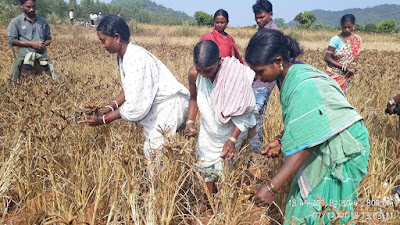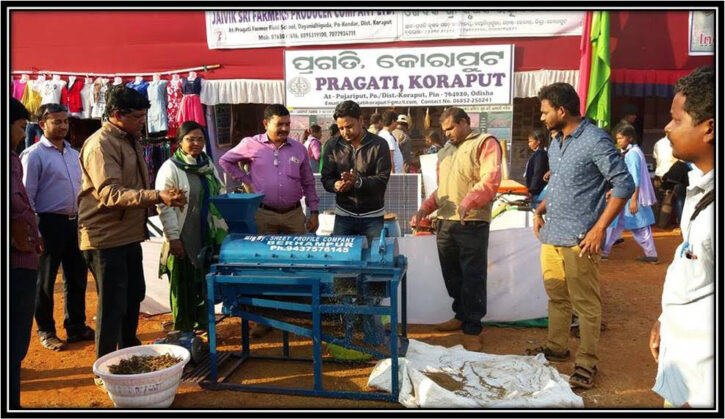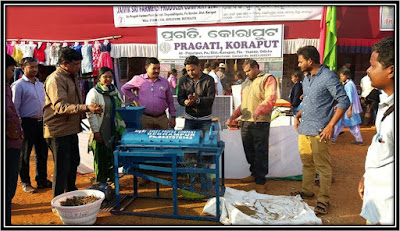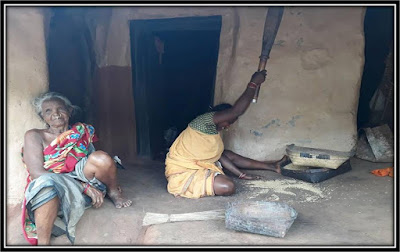Post Harvest Operations of Finger Millet:
Finger Millet is one of the major crops in the Koraput District Of Odisha. It is mostly cultivated in the tribal areas in the Kharif season. The harvesting of finger millet takes place mainly from October to November. There are two methods of harvesting. One is harvesting of only panicles and the other is the harvesting of stalks along with the panicles.
 |
| Harvesting of only panicles of Finger Millet. |
Finger Millet Threshing:
Threshing is the process of loosening the edible part of the grain from the chaff. It is the step in grain preparation after reaping. Threshing does not remove the bran from the grain.
(Figure: No. of sample households using different methods for threshing Finger Millet)
Threshing can be done manually by using sticks or by bullocks or by using a tractor or by machines. Out of the 100 household sample 86 percent of them do the threshing manually followed by bullocks (9 percent) and tractor (4 percent). Finger Millet threshed manually on the mud floor increases impurities such as mud, sand, and dust particles. This makes further processing difficult.
To solve the threshing problem, there is OUAT Ragi thresher cum pearler which can be used for threshing, pearling, and cleaning operation. The machine comprises of a hopper, threshing cylinder, oscillating sieves, and an aspirator type blower.
Finger Millet ear heads are fed through a tray-type hopper for threshing and pearling operations to be accomplished simultaneously inside the threshing cylinder while cleaning is achieved through an adjustable aspirator.
The output of the OUAT Ragi thresher cum pearler was found to be 90 kg/hour with 93.5% threshing efficiency and 92.4% cleaning efficiency.
(Photo: Checking the efficiency of the OUAT Ragi thresher cum pearler in the PARAB Ground, Koraput. This was demonstrated by PRAGATI, Koraput. )
Finger Millet Primary Processing:
Finger millet – are naked grains, i.e. do not have a husk layer. Processing these for human consumption is essentially a matter of cleaning and grading the grains. They are then ground up to either their flour form or into grits making them ready for cooking. This ease of processing is one of the reasons for these grains to persist in the local communities’ diets.
(Photo: Primary processing by hand pounding`)
The entire household sample interviewed, does their primary processing of Finger millet by hand pounding to remove the bran which is bound very tightly to the endosperm. Pounding by hand is very laborious, time-consuming, and inefficient. It gives a non-uniform product that has poor keeping qualities.
Secondary Processing of Finger Millet:
Milling: – It is the processing stage for the grain of finger millet, in which the grain is pulverized in the form of flour for making different food products. It is generally done by some conventional or modern equipment like a stone mill, ball mill, hammer mill or burr mill, etc.
At the household level, milling should be done by hand grinding. After cleaning, seeds should be passed through friction mills, so that glumes separate from it. After it, the grain can be used for pulverizing. Fine flour and coarse flour can be prepared based upon the requirement. The fine flour can be used for making Chapattis (millet bread), while the coarse flour of finger millet can be used for making Laddus (sweet balls).
Most of the sample households (69 percent) do their milling by using traditional chhaki and the rest (30 percent) by pulverizer. It was found that the sample households near to market availed the service of pulverizer.
(Figure: Secondary processing by sample households)
Due to the lack of innovation of post harvest operations of Finger Millet technologies in rural areas, there is a lot of drudgeries. In order to address the processing appropriate mechanization is the need of the hour. The modern mechanization will definitely improve the consumption of finger millet in the rural as well as in the urban areas.
***Looking forward to your innovative ideas and technologies.






